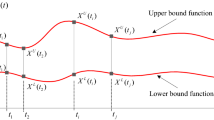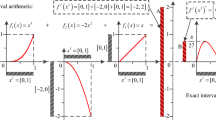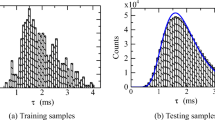Abstract
Interval process is a preferable model for time-varying uncertainty propagation of dynamic systems when only the range of uncertainties can be obtained. However, for nonlinear systems, except for Monte Carlo (MC) simulation, there are still few efficient uncertainty propagation methods under the interval process model. This paper develops a non-intrusive and semi-analytical uncertainty propagation method, named the “convex model linearization method (CMLM),” by constructing a linearization formulation of a nonlinear system in a non-probabilistic sense. First, the criterion to evaluate the difference between the original system and the linearization formulation is derived, represented by the discrepancy of middle point, radius and correlations of response. By minimizing these three parameters, the coefficients of linear equations will be optimized to obtain the linearization formulation of the original system. Then, analytical equations are built to calculate uncertainty response under the interval process, without time-consuming analysis of the original system. To further improve the efficiency of the linearization process, Chebyshev polynomial is introduced to approximate the nonlinear dynamic analysis. Two numerical examples of duffing oscillators and vehicle rides are set to test the proposed CMLM. Compared to the MC method, with comparable uncertainty response precision, the CMLM just needs 1–10% times of dynamic analyses of the nonlinear system. Furthermore, a practical launch vehicle ascent trajectory problem with black-box dynamics is solved by, respectively, the CMLM and MC method. The results verify the capacity of the CMLM to deal with black-box problems and show that the CMLM performs better in terms of accuracy, efficiency and robustness.

















Similar content being viewed by others
Data availability
The complete source code (written in MATLAB) of the method applied in the two numerical tests and the LV ascent trajectory problem, as well as the source code of corresponding MC simulations, is provided in the supplementary material. The source code of the CMLM applied in Duffing oscillator analysis, vehicle ride analysis, and Problem 1 and Problem 2 of LV ascent trajectory are supplied in the folder “CMLM,” which are, respectively, named as: “CMLM_Duffing.m,” “CMLM_VehicleRide.m,” “CMLM_LVtrajectory_1stStage.m” and “CMLM_LVtrajectory_2nd3rdStage.m.” The source code of the MCS for Duffing oscillator analysis, vehicle ride analysis, and Problem 1 and Problem 2 of LV ascent trajectory are supplied in the folder “MCS,” which are, respectively, named as: “MCS_Duffing.m,” “MCS_VehicleRide.m,” “MCS_LVtrajectory_1stStage.m” and “MCS_LVtrajectory_2nd3rdStage.m.”
References
Brake, M.R.: The role of epistemic uncertainty of contact models in the design and optimization of mechanical systems with aleatoric uncertainty. Nonlinear Dynam. 77(3), 899–922 (2014). https://doi.org/10.1007/s11071-014-1350-0
Arailopoulos, A., Giagopoulos, D.: Nonlinear constitutive force model selection, update and uncertainty quantification for periodically sequential impact applications. Nonlinear Dynam. 99(4), 2623–2646 (2020). https://doi.org/10.1007/s11071-019-05444-1
Benedetti, K.C.B., Gonçalves, P.B.: Nonlinear response of an imperfect microcantilever static and dynamically actuated considering uncertainties and noise. Nonlinear Dynam. 107(2), 1725–1754 (2022). https://doi.org/10.1007/s11071-021-06600-2
Astill, C.J., Imosseir, S.B., Shinozuka, M.: Impact loading on structures with random properties. Journal of Structural Mechanics 1(1), 63–77 (1972). https://doi.org/10.1080/03601217208905333
Geller, D.K.: Linear covariance techniques for orbital rendezvous analysis and autonomous onboard mission planning. J. Guid. Control Dynam. 29(6), 1404–1414 (2006). https://doi.org/10.2514/1.19447
Jin, K., Geller, D., Luo, J.: Development and validation of linear covariance analysis tool for atmospheric entry. J. Spacecraft Rockets 56(3), 854–864 (2018). https://doi.org/10.2514/1.A34297
Reardon, D., Leithead, W.E.: Statistical linearization: a comparative study. Int. J. Control 52(5), 1083–1105 (1990). https://doi.org/10.1080/00207179008953585
Prabhakar, A., Fisher, J., Bhattacharya, R.: Polynomial chaos-based analysis of probabilistic uncertainty in hypersonic flight dynamics. J. Guid. Control Dynam. 33(1), 222–234 (2010). https://doi.org/10.2514/1.41551
Jones, B.A., Doostan, A., Born, G.H.: Nonlinear propagation of orbit uncertainty using non-intrusive polynomial chaos. J. Guid. Control Dynam. 36(2), 430–444 (2013). https://doi.org/10.2514/1.57599
Bhusal, R., Subbarao, K.: Generalized polynomial chaos expansion approach for uncertainty quantification in small satellite orbital debris problems. J. Astronaut. Sci. 67(1), 225–253 (2020). https://doi.org/10.1007/s40295-019-00176-1
Elishakoff, I.E., Elisseeff, P., Glegg, S.A.L.: Nonprobabilistic, convex-theoretic modeling of scatter in material properties. Aiaa J. 32, 843–849 (1994)
Zadeh, L.A.: Fuzzy sets as a basis for a theory of possibility. Fuzzy Set. Syst. 100, 9–34 (1999). https://doi.org/10.1016/S0165-0114(99)80004-9
Ben-Haim, Y., Elishakoff, I.E.: Convex models of uncertainty in applied mechanics, 1990. (1990)
Marano, G.C., Quaranta, G.: Robust optimum criteria for tuned mass dampers in fuzzy environments. Appl. Soft Comput. 9(4), 1232–1243 (2009). https://doi.org/10.1016/j.asoc.2009.03.010
Wei, S., Zhao, J., Han, Q., Chu, F.: Dynamic response analysis on torsional vibrations of wind turbine geared transmission system with uncertainty. Renew. Energ. 78, 60–67 (2015). https://doi.org/10.1016/j.renene.2014.12.062
Wang, Z., Tian, Q., Hu, H.: Dynamics of spatial rigid–flexible multibody systems with uncertain interval parameters. Nonlinear Dynam. 84(2), 527–548 (2016). https://doi.org/10.1007/s11071-015-2504-4
Peng, H., Shi, B., Wang, X., Li, C.: Interval estimation and optimization for motion trajectory of overhead crane under uncertainty. Nonlinear Dynam. 96(2), 1693–1715 (2019). https://doi.org/10.1007/s11071-019-04879-w
Wu, J., Zhang, Y., Chen, L., Luo, Z.: A Chebyshev interval method for nonlinear dynamic systems under uncertainty. Appl. Math. Model. 37(6), 4578–4591 (2013). https://doi.org/10.1016/j.apm.2012.09.073
Wu, J., Luo, Z., Zhang, Y., Zhang, N., Chen, L.: Interval uncertain method for multibody mechanical systems using Chebyshev inclusion functions. Int. J. Numer. Meth. Eng. 95(7), 608–630 (2013). https://doi.org/10.1002/nme.4525
Li, C., Chen, B., Peng, H., Zhang, S.: Sparse regression Chebyshev polynomial interval method for nonlinear dynamic systems under uncertainty. Appl. Math. Model. 51, 505–525 (2017). https://doi.org/10.1016/j.apm.2017.06.008
Fu, C., Ren, X., Yang, Y., Lu, K., Qin, W.: Steady-state response analysis of cracked rotors with uncertain-but-bounded parameters using a polynomial surrogate method. Commun. Nonlinear Sci. 68, 240–256 (2019). https://doi.org/10.1016/j.cnsns.2018.08.004
Fu, C., Ren, X., Yang, Y., Lu, K., Wang, Y.: Nonlinear response analysis of a rotor system with a transverse breathing crack under interval uncertainties. Int. J. Nonlin. Mech. 105, 77–87 (2018). https://doi.org/10.1016/j.ijnonlinmec.2018.07.001
Wang, L., Chen, Z., Yang, G.: A polynomial chaos expansion approach for nonlinear dynamic systems with interval uncertainty. Nonlinear Dynam. 101(4), 2489–2508 (2020). https://doi.org/10.1007/s11071-020-05895-x
Wang, L., Yang, G.: An interval uncertainty propagation method using polynomial chaos expansion and its application in complicated multibody dynamic systems. Nonlinear Dynam. 105(1), 837–858 (2021). https://doi.org/10.1007/s11071-021-06512-1
Jiang, C., Zhang, Q.F., Han, X., Liu, J., Hu, D.A.: Multidimensional parallelepiped model—a new type of non-probabilistic convex model for structural uncertainty analysis. Int. J. Numer. Meth. Eng. 103(1), 31–59 (2015). https://doi.org/10.1002/nme.4877
Ni, B.Y., Jiang, C., Han, X.: An improved multidimensional parallelepiped non-probabilistic model for structural uncertainty analysis. Appl. Math. Model. 40(7), 4727–4745 (2016). https://doi.org/10.1016/j.apm.2015.11.047
Jiang, C., Han, X., Lu, G.Y., Liu, J., Zhang, Z., Bai, Y.C.: Correlation analysis of non-probabilistic convex model and corresponding structural reliability technique. Comput. Method. Appl. M. 200(33), 2528–2546 (2011). https://doi.org/10.1016/j.cma.2011.04.007
Jiang, C., Ni, B.Y., Han, X., Tao, Y.R.: Non-probabilistic convex model process: A new method of time-variant uncertainty analysis and its application to structural dynamic reliability problems. Comput. Method. Appl. M. 268, 656–676 (2014). https://doi.org/10.1016/j.cma.2013.10.016
Jiang, C., Li, J.W., Ni, B.Y., Fang, T.: Some significant improvements for interval process model and non-random vibration analysis method. Comput. Method. Appl. M. 357, 112565 (2019). https://doi.org/10.1016/j.cma.2019.07.034
Jiang, C., Liu, N.Y., Ni, B.Y.: A monte carlo simulation method for non-random vibration analysis. Acta Mech. 228(7), 2631–2653 (2017). https://doi.org/10.1007/s00707-017-1842-3
Ni, B.Y., Jiang, C., Li, J.W., Tian, W.Y.: Interval K-L expansion of interval process model for dynamic uncertainty analysis. J. Sound Vib. 474, 115254 (2020). https://doi.org/10.1016/j.jsv.2020.115254
Fragkoulis, V.C., Kougioumtzoglou, I.A., Pantelous, A.A.: Statistical linearization of nonlinear structural systems with singular matrices. J. Eng. Mech. 142(9), 4016063 (2016). https://doi.org/10.1061/(ASCE)EM.1943-7889.0001119
Ni, B.Y., Jiang, C., Huang, Z.L.: Discussions on non-probabilistic convex modelling for uncertain problems. Appl. Math. Model. 59, 54–85 (2018). https://doi.org/10.1016/j.apm.2018.01.026
Jiang, C., Ni, B.Y., Liu, N.Y., Han, X., Liu, J.: Interval process model and non-random vibration analysis. J. Sound Vib. 373, 104–131 (2016). https://doi.org/10.1016/j.jsv.2016.03.019
Wu, J., Luo, Z., Zhang, N., Zhang, Y.: A new sampling scheme for developing metamodels with the zeros of Chebyshev polynomials. Eng. Optimiz. 47(9), 1264–1288 (2015). https://doi.org/10.1080/0305215X.2014.963071
Kamen, E.: Fundamentals of linear time-varying systems. In: Levine, W.S. (ed.) The control systems handbook, pp. 451–458. CRC Press, Boca Raton, FL, USA (1996)
Li, J., Jiang, C., Ni, B., Zhan, L.: Uncertain vibration analysis based on the conceptions of differential and integral of interval process. Int. J. Mech. Mater. Des. 16(2), 225–244 (2020). https://doi.org/10.1007/s10999-019-09470-0
Brevault, L., Balesdent, M.: Uncertainty quantification for multidisciplinary launch vehicle design using model order reduction and spectral methods. Acta Astronaut. 187, 295–314 (2021). https://doi.org/10.1016/j.actaastro.2021.06.040
Zhao, J., Li, H., He, X., Huang, Y., Liu, J., Lo Schiavo, A.: Uncertainty analysis for return trajectory of vertical takeoff and vertical landing reusable launch vehicle. Math. Probl. Eng. 2020, 4313758 (2020). https://doi.org/10.1155/2020/4313758
Zheng, X., Ma, N., Gao, C., Jing, W.: Propagation mechanism analysis of navigation errors caused by initial state errors for long-range vehicles. Aerosp. Sci. Technol. 67, 378–386 (2017). https://doi.org/10.1016/j.ast.2017.04.016
Funding
The present work was supported by the major advanced research project of Civil Aerospace from State Administration of Science, Technology and Industry of China.
Author information
Authors and Affiliations
Corresponding author
Ethics declarations
Conflict of interest
On behalf of all authors, the corresponding author states that there is no conflict of interest.
Additional information
Publisher's Note
Springer Nature remains neutral with regard to jurisdictional claims in published maps and institutional affiliations.
Appendices
Appendix 1
1.1 Derivation of CMLM criterion
By the weighted sum of e1, e2 and e3, a comprehensive index e can be established. The weighting coefficients are first determined. The index e1 is independent because it is only related to M and not to N. Thus, its weighting coefficient can be defined as 1, and the value does not affect the optimal value of M and N. Then, to achieve the weighted sum of e2 and e3 in an equivalent order of magnitude, they are compared in a similar form represented by covariances:
From the comparison, it is obvious that e3 should be weighted by
Then e2 and e3 can be weighted equivalently, and e is finally expressed as:
where the SCC ρs is defined as:
where xIi and xIj are two interval variables; and x i(s) and x j(s) are sampling points of xIi and xIj. Therefore, the SCC of the uncertain value of the nonlinear function and its approximate linear function can be calculated as:
where
Thus,
The SCC between the uncertain value of the nonlinear function and its uncertain inputs can be calculated as:
Then substitute (67) into (66) that
Through the substituting (69) into (62), e can be expressed as:
Moreover,
Finally, e can be calculated as:
Appendix 2
2.1 Approach to taking samples in a MEM domain
The characteristic matrix G to describe a MEM can be decomposed by eigenvalue decomposition as:
where D is eigenvalue matrix; Q is eigenvector matrix; and QTQ = I. The samples, x(s), uniformly distributed in a “multidimensional ellipsoid” can be obtained through a transformation (73) from the sampling points, U.(s), uniformly distributed in a unit hyper-sphere[28]
where xM is a vector of the middle points of the interval variables. For a k-dimensional problem, every single set of sampling points U(s) can be calculated in the spherical coordinates (r, θ1, θ2, …, θk-1) as:
where r(s) are the sampling points lie in a one-dimensional IM with range [0, 1] and [θ1(s), θ2(s), …, θk-1(s)] are the sampling points lying in a (k-1)-dimensional IM with range [0, 2π] of every dimension.
Finally, the sampling points in the MEM domain can be obtained by taking samples in the above IMs conventionally. Incidentally, through the approach, the scanning method and MC simulation can also be achieved by taking samples orthogonally and randomly, respectively.
Appendix 3
3.1 Model of LV flight dynamics
The detailed expansion of the LV flight dynamics model is expressed as
where m is the mass of LV; [P, 0, 0]T is the component of propulsion P; [Xc, Yc, Zc]T are the components of control force Fc; and [X, Y, Z]T are the components of aerodynamic force R, which can be calculated as:
where α and β are the angle of attack and sideslip angle, respectively. Cx is the drag coefficient, and Cyα is the derivative of the lift coefficient with respect to α; SR is the reference surface area; and q is the dynamic pressure, which is calculated as:
where ρ is the atmospheric density and v is the resultant velocity of the LV flight as
Then, GB and GV are coordinate transform matrixes as:
where φ and ψ are, respectively, the pitch angle and yaw angle, which describe the flight attitude of the LV. Meanwhile, θ and σ are, respectively, flight path angle and flight path azimuth angle, which describe the flight direction of the LV. These angles can be derived as:
Moreover, A and B, in(75), are the matrixes to describe inertial force caused by the rotation of the earth as:
where ωe is the earth rotation rate and [ωex, ωey, ωez]T are the components of the vector ωe. Afterward, [R0x, R0y, R0z]T, in (75), are the components of the vector R0 to describe the position of the launch point. Next, gr and gωe are the components of gravitational acceleration and can be calculated as:
where μ and J are the constant characteristics of gravity. ae is the length of the semimajor axis of the earth under an ellipsoid model; besides, the semiminor axis is symbolled by be. And, r, the geocentric distance of the LV, is calculated as:
Meanwhile, ϕ, the geocentric latitudinal, can be derived from:
In addition, the flight height of the LV can also be obtained by r and ϕ as:
Finally, these equations can be solved according to a given flight program angle, and generally, they are provided in the form:
Accordingly, to achieve the flight program, the corresponding α and β are expressed as
where Aφ and Aψ are both constant coefficients.
Rights and permissions
Springer Nature or its licensor (e.g. a society or other partner) holds exclusive rights to this article under a publishing agreement with the author(s) or other rightsholder(s); author self-archiving of the accepted manuscript version of this article is solely governed by the terms of such publishing agreement and applicable law.
About this article
Cite this article
Zhang, L., Li, C., Su, H. et al. A novel linear uncertainty propagation method for nonlinear dynamics with interval process. Nonlinear Dyn 111, 4425–4450 (2023). https://doi.org/10.1007/s11071-022-08084-0
Received:
Accepted:
Published:
Issue Date:
DOI: https://doi.org/10.1007/s11071-022-08084-0




